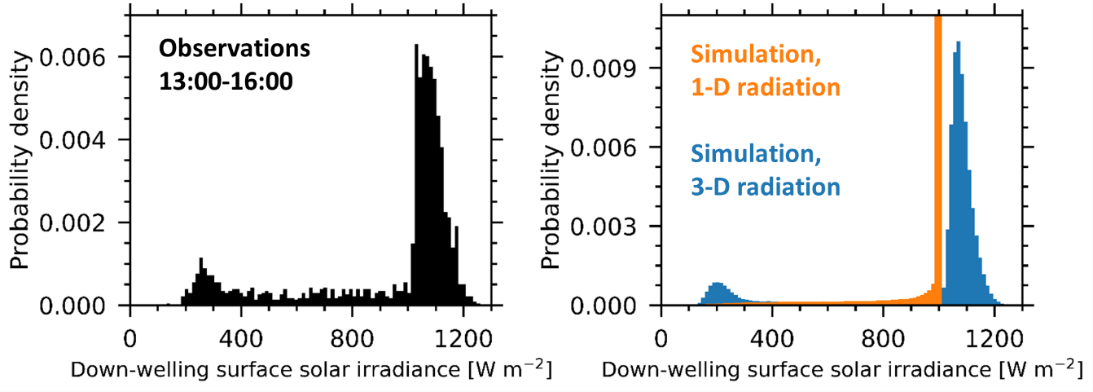Surface Solar Radiation Variability in Complex Cloud-Aerosol Environments: New Insights from Observations and High-Resolution Simulations
J. Gristey1,2, G. Feingold2, I.B. Glenn3, K.S. Schmidt4 and H. Chen4
1Cooperative Institute for Research in Environmental Sciences (CIRES), University of Colorado, Boulder, CO 80309; 720-491-1089, E-mail: Jake.J.Gristey@noaa.gov
2NOAA Chemical Sciences Laboratory (CSL), Boulder, CO 80305
3Joint Institute for Regional Earth System Science and Engineering (JIFRESSE), UCLA, Los Angeles, CA 90095
4University of Colorado, Laboratory for Atmospheric and Space Physics (LASP), Boulder, CO 80309
Ubiquitous shallow cumulus clouds exhibit detailed three-dimensional (3D) spatial structure leading to complex variability in surface solar irradiance (SSI). Hygroscopic aerosol embedded in the cloud field introduces additional scattering and absorption, further modulating SSI. The SSI variability in this environment is encapsulated by the shape of the SSI probability density function (PDF), which is typically bi-modal representing separately the cloud shadows and the gaps between (e.g., Fig. 1a). However, detailed understanding of the relationship between cloud and aerosol properties, and the SSI PDF shape, has remained elusive. Here, we compare observations of SSI at the Southern Great Plains Atmospheric Observatory in Oklahoma, with simulated SSI derived from large eddy simulation and Monte-Carlo 3D radiative transfer for a variety of shallow cumulus cases. First, this presentation will reveal the stark differences between simulated SSI when 3D radiative effects are included or neglected (e.g., Fig. 1b). The observed SSI PDF shape is only reproduced when 3D radiative effects are included, providing direct observational evidence for 3D radiative effects. Next, a machine learning framework will be introduced for predicting the SSI PDF using just a handful of key cloud and aerosol properties. It will be demonstrated how well the SSI PDF can be predicted relative to traditional 1D radiative transfer, while bypassing the computational expense of 3D radiative transfer. Finally, machine learning inference techniques will be described that permit quantification of the relative importance of each predictor and aid in the understanding of physical controls on SSI variability, thereby uncovering the key role of aerosol embedded in the cloud field. The new findings have important implications for solar renewable energy assessment and highlight the potential significance of shortwave 3D radiative effects in atmospheric modeling. Opportunities and challenges for future parameterization of shortwave 3D radiative effects in high-resolution atmospheric models will be discussed.
Figure 1. Probability density functions of down-welling surface solar irradiance at the Southern Great Plains atmospheric observatory on June 27 2015 from 13:00-16:00 local time, based on (a) observations and (b) large eddy simulation employing 1-D (orange) and 3-D (blue) radiative transfer.

